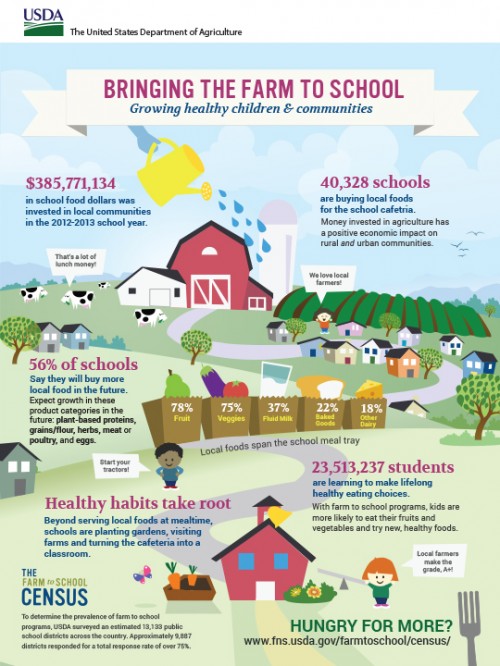Farm-to-institution programs create partnerships between local farmers and communities via schools, public institutions, restaurants and businesses. Farmers benefit from increased business; the community benefits from the dollars kept in the region; and the eaters — be they schoolchildren or hospital patients in particular need of a healthy diet — benefit from the nutrients of local produce. Here are some articles we’ve been reading about farm-to-institution programs across the U.S.:

1. New USDA Census Results Show 23.5 Million Kids Participating in Farm to School
This infographic shows data gathered from 1,500 school districts nationwide and reveals that school farming efforts are worth their salt.
2. Rehabilitating Hospital Food: Aiming for Healthy, Sustainable and Savory
The U.S. healthcare industry spends about $12 billion per year on food procurement. According to this article from The Guardian, the San Francisco-based nonprofit Physicians for Social Responsibility “realized that, by pooling their purchasing power, they could prod the mainstream food distribution chain to include more sustainably produced items – and, in the process, maybe turn the stereotype of bad hospital food on its head.” By reducing meat purchasing, cooking local produce and adding nutritional information to hospital cafeteria receipts, the organization hopes to influence mainstream food procurement toward local, sustainable sourcing.
3. How a Farm-to-Table Program Could Revitalize Prisons
A San Diego prison is building a three-acre farm onsite for its new Farm and Rehabilitation Meals (FARM) program, which will hire 20 inmates as farmers and train them in sustainable agriculture practices. Once approved by the prison health authorities, the farm will provide the prison kitchen with fresh produce, leading to reduced spending and increased nutrition. Research shows that inmate farmers have prison low reentry rates of 5-10 percent, compared to California’s overall reentry rate of 61 percent.
4. Free for All: Fixing School Food in America
In this book, WhyHunger board member and author Janet Poppendieck explores the multifaceted challenges that schools face when developing meal programs, such as nutrition standards, sustainability, national policy, child-directed advertising and child behavior. She argues that fresh, healthy and universally free school meals are not only possible but necessary for the U.S. school system.
5. “From Field to Fork”: Food Banks Start Farming to Feed Needy
Many recipients of in-kind food assistance receive processed and canned foods, which often contain higher calorie counts and lower nutrition levels than fresh foods. In the Trenches is a food pantry in Detroit, Michigan that works directly with a farm to grow fresh produce for their food pantry clients, an innovative strategy for getting fresh foods into the hands of low-income families. Forgotten Harvest, the food rescue group that runs the farm, located an hour outside of Detroit, is working to triple their current harvest to grow 2.8 million pounds of produce this year. The challenges that come with this model are plenty, but the rewards of feeding healthy food to the community outweigh the difficulties.
Read more at the Farm-to-Institution topic on the Food Security Learning Center.


